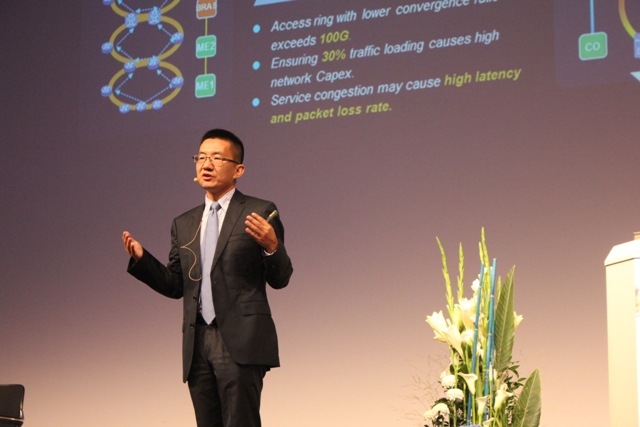Huawei Unveils Three Innovative Network Solutions at ECOC 2016
Helping to Drive Operators' Digital Transformation
[Dusseldorf, Germany, September 19, 2016] Huawei unveiled three innovative network solutions aligned with future network trends (large capacity, low latency and intelligence) at the 42nd European Conference on Optical Communications (ECOC 2016) in Dusseldorf.

Jeffrey Gao, President of Huawei's Transmission Network Product Line, making speech on Transport Network Transformation & Technology Prospects in ECOC 2016
With large-capacity network bearers in mind, Huawei launched the 80T ultra large-capacity beyond-1000km transmission solution, helping to fix the transmission rate bottleneck that has burdened operators' backbone bearer networks. This solution implements 1000km ultra-long-haul transmission at the single-carrier rate of 500 Gigabits per second (Gbit/s) in the 128QAM higher-order modulation format by using advanced ODSP/SDFEC signal processing technologies.
The system employs 160 wavelengths to cover all the C and L bands and achieves a record high of 80 Terabits per second (Tbit/s) for single-fiber capacity.
For low latency, Huawei has released Flex-Grid, a sub-wavelength all-optical cross-connect technology capable of processing extremely-fine-grained spectra. This technology extended the traditional optical cross-connection capability from the wavelength level to the sub-wavelength level. Previously, there was a technical bottleneck where the service granularity at the convergence layer or access layer was too small to provide rapid optical switching. This technology, however, allows for end-to-end all-optical switching (with all granularities and ultra-low latency) and one-hop transmission from the core layer to the access layer.
With regards to intelligent networks, Huawei has developed the innovative Virtual Network Engine (VNE). The VNE is built with five core capabilities: automatic network resource allocation, self-service network management, effective resource utilization, secure resource management, and service diversity. These serve to meet operators' networking and automated management requirements, provide network self-sensing and self-management capabilities, and enable industry operations and maintenance (O&M) to move into the intelligence era.
Jeffrey Gao, President of Huawei's Transmission Network Product Line, stated in his keynote speech that under the driving force of emerging services such as 4K/8K high-definition (HD) videos, data center (DC) cloud interconnection and next-generation mobile bearers, future network architecture will be simplified. He also stated that ultra-large capacity, ultra-low latency, and intelligence will be three key network values. These points will help operators overcome difficulties in increasing network bandwidth and achieve digital transformation of future DC-centric networks.
As an active driver of the global optical network market, Huawei has not only been a leader in optical transmission for many years, but also maintains long-term strategic investments in optical transmission technology research and innovation. Huawei tirelessly works to enrich people's communication abilities and lives through technological innovation and close collaboration with industry partners.
As the leading optical communication technology and industry conference in Europe, ECOC had tens of thousands of industry leaders in both upstream and downstream industries from over 40 countries in attendance. Additionally, more than 300 vendors displayed their latest products and technologies at ECOC.
The Ultra-Broadband Forum (UBBF) 2016 will be held in Frankfurt Germany on September 29 and 30. All parties interested in Ultra-broadband are welcome to attend!

